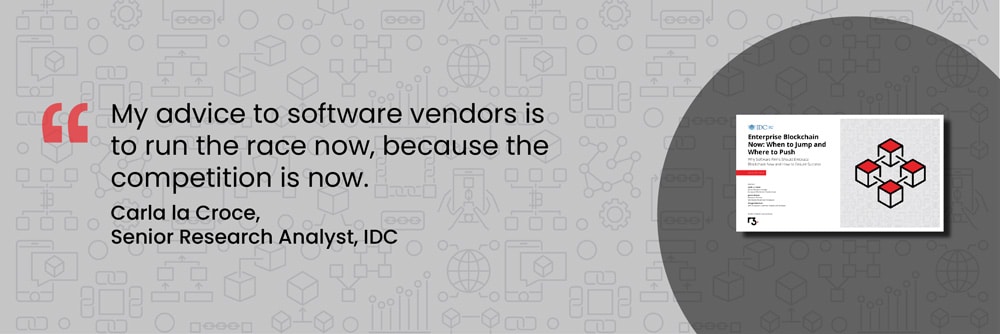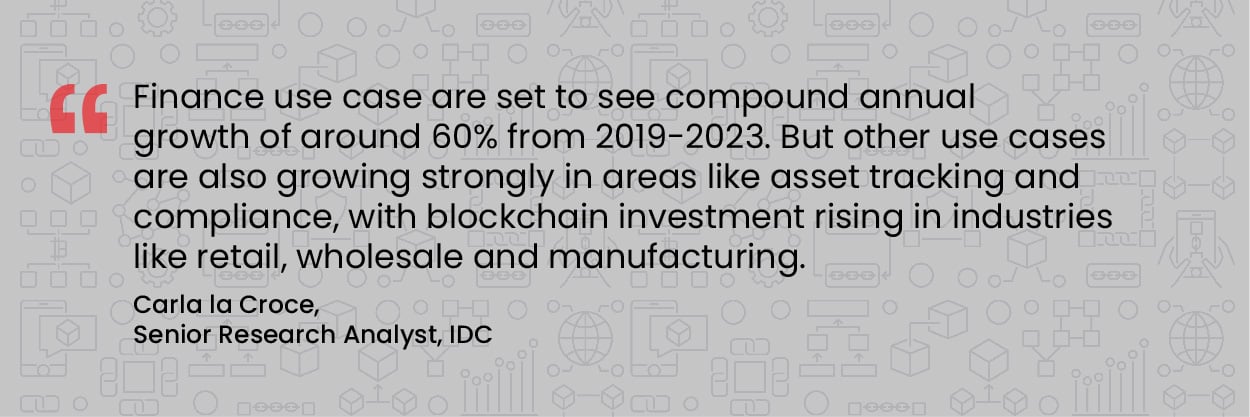Enterprise Blockchain Report by IDC and R3 Highlights Opportunities for Software Firms

Research firm IDC has just published a report with R3–“When to Jump and Where to Push”–examining why software firms should embrace enterprise blockchain technology now, and how they can ensure success when doing so. It’s a must-read for any independent software vendor (ISV). To get an expert perspective on the findings, I caught up with Carla la Croce, senior research analyst for IDC’s European Industry Solutions, Customer Insights & Analysis group, and Cathy Minter, CRO of R3, to discuss why blockchain is compelling for ISVs–and why now.
Activate your network – Independent Software Vendors (ISVs) and blockchain
I began by asking Carla from IDC what challenges software firms are facing that make now such a good time to invest in blockchain. She explained: “With blockchain, a software company can leverage its network to entrench its software more deeply, driving collaboration and the network effects of new value propositions. And by applying blockchain to existing networks, ISVs can also increase the penetration of current software–an effect we’re seeing consistently with major Fintech organizations, for example.”
How blockchain technology addresses supply chain pain points
Carla added that the COVID-19 crisis has boosted blockchain’s relevance still further, including specifically blockchain technology within supply chains. “The pandemic has highlighted the importance of investing in technology that can deliver value more quickly and the importance of being positioned to recover quickly,” she said. “What’s very important today is to differentiate existing software offerings by addressing key issues that have been exposed in recent times, often driven by difficulties in collaborating effectively across firms to drive more efficient transactions. This could mean looking at blockchain through the window of the pain points revealed by the crisis, such as challenges of reconciling data and transactions across the physical and financial supply chain, or a lack of connectivity and transparency in supply chains amid the disruption.”
But how are these drivers playing out among the software community? Turning to Cathy, I asked what she’s hearing from R3’s customers at the moment and why blockchain is increasingly compelling. She highlighted that every established tech firm is currently focused on how to adapt to the COVID “new normal” and what this means in terms of its digital transformation strategies. Those that identified enterprise blockchain as a foundational technology are seeing how this can position them to capture the network effects of such solutions as the market starts to improve. At the same time, she is seeing a strong interest in blockchain among newer players. “There’s a community of smaller software firms and start-ups that are focusing on blockchain to build decentralized applications or to go after a specific market. This is now firmly on the radar of more established vendors, as some of these start-ups are scaling very quickly,” she said.
Where to jump?
I then went on to ask which blockchain use cases are gaining the greatest traction. Carla highlighted several examples, including the use of R3’s Corda Enterprise by technology firms NTT Data and SIA to transform the SPUNTA reconciliation process among Italian banks. “The collaborative SPUNTA solution is a perfect example of choosing an optimal use case because of the challenges with the current process,” said Carla. “The result has been the creation of the biggest interbank blockchain ecosystem for reconciliation–one that includes the Italian banking regulator and has 100 banks or so live.”
Carla also highlighted Nasdaq’s Market Technology arm as a tech firm using Corda to transform the way business is done–and she stressed that momentum is growing across many industries. “The recent Nasdaq project through its Market Technology arm promises to provide solutions that enable exchanges to move from traditional ways of issuing, trading and settling financial instruments to new mechanisms that allow for the end to end management of digital assets,” she said. “We are also seeing traction for use cases in many other industries and sectors ranging from automotive supply chains, to trade finance to pharma and food. COVID-19 has also highlighted the need for greater trust and security in data shared between parties. ISVs are targeting opportunities to use blockchain to build new apps that meet specific needs around this, but that can also combine and bring more value to other technologies such as cloud, data analytics and AI.”

So, as IDC launches its blockchain spending guide, what does this growing traction mean for actual investment in blockchain solutions? From a vendor perspective, Carla said the use of blockchain technology in the banking and financial sectors, in general, continues to have the strongest adoption, with spending proving resilient despite the COVID-19 slowdown. “Finance use cases are set to see compound annual growth of around 60% from 2019-2023,”’ she said. “But other use cases are also growing strongly in areas like asset tracking and compliance, with blockchain investment rising in industries like retail, wholesale, and manufacturing. The drivers here are around authenticity and the origin of goods, to prevent fraud and improve customer loyalty and satisfaction. And on top of the sectors, I’ve mentioned, other industries seeing growing blockchain-enabled innovation include utilities and energy in the longer term.”
Corporates and institutions look to software firms for support
All of this activity underlines the large and growing market for blockchain-based solutions that vendors can target. “In terms of technology spend, blockchain services and software development are still driving spending–because what companies are asking for is more support on their journey from ideation of a blockchain use case, to the delivery of the applications and support on the other aspects of building a blockchain network,” said Carla. “If you consider that in 2023 global blockchain spending will be more than US$14 billion, a quarter of that spending will be on blockchain software. This is the opportunity that software providers should look at. And by taking an ecosystem approach the network effects potentially drive exponentially higher revenue for software firms as networks grow. So it is increasingly important to consider enterprise blockchain as part of the digital transformation journey.”
The time is now
As momentum and spending grow, and innovation zeroes in on real-world business problems, what trends are we seeing from a product perspective? “As we move from the developer space out into the business, people don’t really care how the sausage is made, so to speak!” explained Cathy. “They want solutions and they want them fast, without needing to understand the complexities of how the tech works. With smartphones we are OK not understanding how they work – we just want the apps on top that make our lives easier. We see blockchain as no different from that, which is why we have invested so much in delivering a platform that developers can pick up easily, and so end users can deploy the infrastructure without barriers. Now there is increasing maturity in managed service-type environments too, so customers are open to accessing the infrastructure and applications in the cloud. We’re seeing cloud and the use of blockchain and other multi-party computing technologies accelerating together.
With some ISV’s well advanced on their blockchain journey, and others just starting off, what tips would Carla and Cathy give the new wave of entrants on how best to get started? “My advice to ISVs is to run the race now because the competition is now,” said Carla. “This means, first, develop a strong message–because when you talk to specific people you need to tailor not only your offering but also your message, depending on whether they’re a CIO, COO or CTO. Second, focus on the tech synergy from blockchain working with other emerging technologies like AI and IoT. Third, think in terms of ecosystem, such as intra or cross-industry consortia.”
Cathy agreed while adding: “Success is about being very focused, looking at the end solution and use cases, and thinking less about the technology and more about the outcomes. For R3, continuing to demonstrate successes like those highlighted in the IDC report will continue to build the confidence we are now seeing in the technology.”
The overall message? The future is bright–for enterprise blockchain and the software houses that are using it as part of their application development stack. As businesses and industries seek ways to deliver more trusted transactions between firms in emerging digital ecosystems there is a big opportunity for leading software firms to drive the change.

The full IDC and R3 InfoBrief is available for download here.



